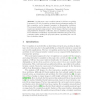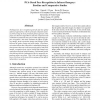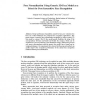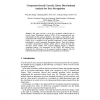AVBPA
2003
Springer
14 years 6 months ago
2003
Springer
Abstract. A number of applications require robust human face recognition under varying environmental lighting conditions and different facial expressions, which considerably vary ...
AC
2003
Springer
14 years 6 months ago
2003
Springer
In this paper a new complete system for 3D face recognition is presented. 3D face recognition presents several advantages against 2D face recognition, as, for example, invariance t...
GLVLSI
2003
IEEE
14 years 6 months ago
2003
IEEE
Design and implementation of a fast parallel architecture based on an improved principal component analysis (PCA) method called Composite PCA suitable for real-time face recogniti...
AVSS
2003
IEEE
14 years 6 months ago
2003
IEEE
In this paper, we present a combined real-time face region tracking and highly accurate face recognition technique for an intelligent surveillance system. Highresolution face imag...
AMFG
2003
IEEE
14 years 6 months ago
2003
IEEE
Techniques for face recognition generally fall into global and local approaches, with the principal component analysis (PCA) being the most prominent global approach. This paper u...
CVPR
2010
IEEE
14 years 6 months ago
2010
IEEE
Real-world face recognition systems often have to face the single sample per person (SSPP) problem, that is, only a single training sample for each person is enrolled in the datab...
SSPR
2004
Springer
14 years 6 months ago
2004
Springer
Abstract. We investigate a number of approaches to pose invariant face recognition. Basically, the methods involve three sequential functions for capturing nonlinear manifolds of f...
SINOBIOMETRICS
2004
Springer
14 years 6 months ago
2004
Springer
Abstract. While face recognition from a single still image has been extensively studied over a decade, face recognition based on more than one still image, such as multiple still i...
SINOBIOMETRICS
2004
Springer
14 years 6 months ago
2004
Springer
Abrupt performance degradation caused by face pose variations has been one of the bottlenecks for practical face recognition applications. This paper presents a practical pose norm...
SINOBIOMETRICS
2004
Springer
14 years 6 months ago
2004
Springer
This paper presents a novel face recognition method based on cascade Linear Discriminant Analysis (LDA) of the component-based face representation. In the proposed method, a face i...




